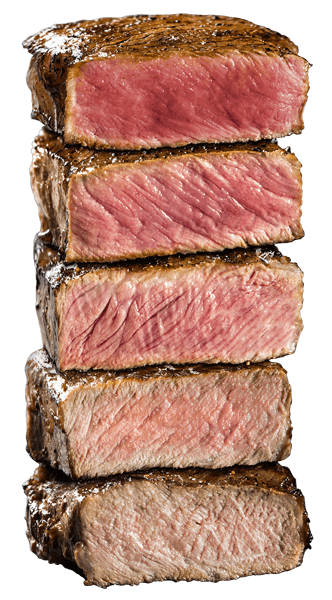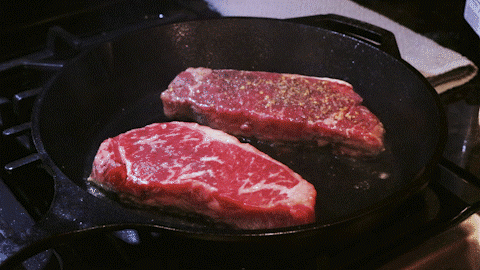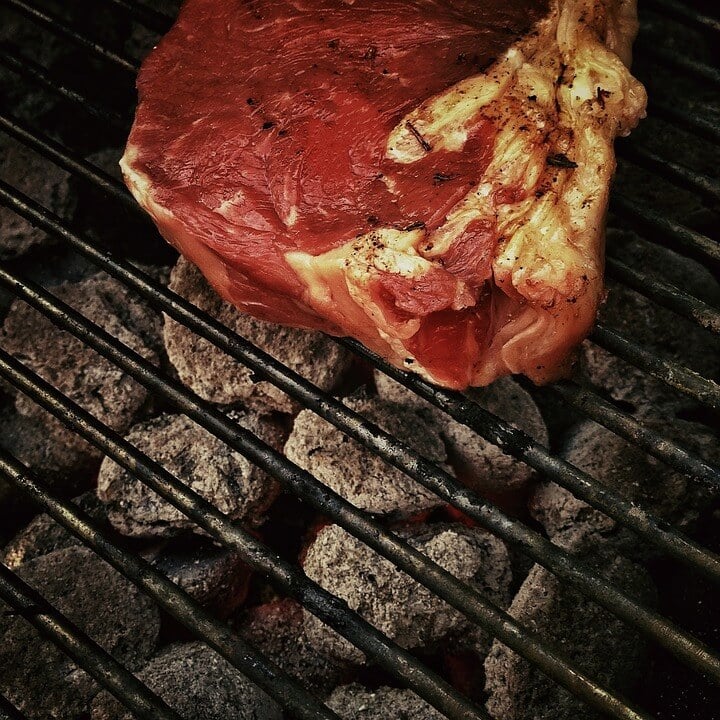Summer’s finally here, and if you stand in your backyard and listen carefully, you’ll hear the beautiful sound of millions of grills being lit across the country.
There is – of course – no better food to grill than a richly marbled, perfectly aged cut of USDA Prime steak. But before you finish tying up the strings on your “Kiss The Chef” apron, it’s best to be sure you have the basics of steak doneness down.
With this guide to Steak doneness, we’ll show you what happens when you cook your steak, what the different levels of doneness are (and what they mean for your steak’s tenderness and flavor), and how you can be sure that you’ve cooked your steak to the perfect level of doneness.
What Cooking Does To Your Steak
There are two parts to grilling a gorgeous ribeye or strip. The first is making sure that the steak reaches a consistent internal temperature. It’s this internal temperature that’s used to determine a steak’s doneness.
When you cook meat, you’re doing three things:
- You’re breaking down it’s proteins: Muscle proteins, which are usually tightly balled, begin to unwind. This is why rawer steaks are chewier than more cooked ones.
- You’re evaporating water: Roughly ¾ of a steak’s muscle fibers are made of water. As you cook a steak, that water evaporates. Hence why a well done steak has less mass and less juiciness than a rare steak.
- You’re melting fat: As you cook your steak, the small streaks and pockets of fat inside start melting. When the fat melts, it gets absorbed into the muscle. This gives your steak a better taste (fat contains the chemicals that gives beef its flavor) and a smoother, more tender and buttery texture.
The second part of grilling is searing. Searing a steak involves exposing its surface to extremely hot temperatures (meaning 500°or hotter) for short periods. This results in what’s called the Maillard effect, and it gives your steak the crunchy, brown flavorful exterior that steak lovers prize.
Steak Doneness Levels
All great steaks require searing (for flavor, texture, and killing surface bacteria). But it’s the internal temperature that determines your steak’s doneness. There are six main levels of doneness you can cook a steak to.
NOTE: You should always pull your steak off the grill when it’s 5° below the temperature you want it to reach. This is because your steak retains heat and will continue to cook and heat up for a few more minutes after you pull it off the grill, making its internal temperature rise.
This steak doneness chart will help you learn the difference between a rare steak and other steak cooking levels (all temperatures are denoted in degrees Fahrenheit):
Blue Rare Steak (115° F)
Also known as Very Rare, Blood Rare, Black & Blue, Pittsburgh Rare, or Bloody As Hell. Blue Rare steaks are only seared on the outside, meaning the inside remains almost completely uncooked and raw. Blue Rare steaks are often still cool on the inside and may be placed in an oven at a low temperature to warm.

Rare Steak Temp (120° F)
Rare steaks have a warm but very red center. This means the surface has the tasty flavor and texture of the Maillard effect, but also means that the steak’s fats have not had a chance to melt properly. Because of this, Rare is an excellent choice for low-fat steaks, such as tenderloins, but should be avoided for well-marbled cuts such as rib-eyes, strips, and porterhouses.
Medium Rare Steak Temp (130° F)
The gold-standard of steak doneness. Ask almost any chef or steak aficionado: Medium Rare means the best tasting, most tender steak you can grill. At this temperature, the steak’s fat has had a chance to melt, distributing butteriness and flavor, but not a lot of moisture has evaporated yet, meaning a supremely tender, juicy, and plump steak. A medium-rare steak is red at the center, with a ring of pinkness between the center and the crust
Medium Steak Temp (140° F)
A medium steak no longer contains a red center, but is pink throughout most of the steak. Medium steaks retain the buttery, flavorful taste of Medium-Rare steaks, but have slightly less juiciness and tenderness, due to moisture loss.
Medium Well Steak Temp (150° F)
Medium Well steaks still retain a little bit of pinkness and tenderness, but have begun to lose enough moisture that they will be drier and less tender than most steak lovers would care for.
Well Done Steak Temp (160° F)
Most chefs and grillmasters would say this level of doneness is poorly named – “Over-Done” would be a better fit. By this point, enough moisture (and fat) has either evaporated or leaked from the steak that you’ll find your meat much drier and tougher than you’d probably like it.
Steak Doneness Cooking Calculator
Not sure how long to cook your steak to your desired doneness level? Use our doneness calculator to know exactly how long to cook your steaks to perfection.
🥩 Steak Cook Time Calculator
Is Rare Steak Safe?
Many people have concerns over eating rare steak that ranges from red to purplish on the inside, and some even avoid eating a medium rare steak with a pink to light pink center. The USDA, in fact, does recommend that steaks get cooked to at least 145 degrees, followed by a resting period of at least three minutes, to ensure their safety.
The reason for this recommendation is that cooking steak to this temperature ensures that it reaches a safe temperature to eat. Beef cooked lower than this temperature with a very pink or red center comes with a higher risk of harmful bacteria multiplying into dangerous levels.
The core temperature you cook a steak to is ultimately up to you to decide, but it’s important to at least be aware that rare and even some medium rare steaks with pink middles might not be the safest to eat. When you order steak at a restaurant, it’s always a good idea to request that your steak be cooked to 145 degrees rather than naming a doneness level, just to be on the safe side.
Determining Temperature
The best way to make sure your steak has reached the temperature and level of doneness you’re looking for is to use a meat thermometer. Find a quality food thermometer that gives accurate readings. Hold it firmly with your thumb and forefinger, and slide it into the side of your steak toward the center for a precise steak temperature reading.
Some people will tell you not to do this, as poking a steak will let the juices leak out. It’s true that some will come out, but it won’t be enough to harm your steak. Plus, it’s more important to get an accurate reading from your instant read thermometer for food safety than it is to hold in the juices!
You can also use the finger test, although checking using your hand and finger isn’t necessarily the most accurate method because it doesn’t check degrees. Different breeds of beef, cuts of meat, and steak thicknesses can cause big variations in how a cooked steak feels to the touch, i.e., its firmness, so it might end up ruining your Wagyu or Kobe-style steak
 Get Grilling
Get Grilling
Now that you know the perfect doneness and temperature to grill your ribeye to (hint hint: Medium Rare, Medium Rare, Medium Rare), it’s time to fire up the grill and become the steak chef you’ve always dreamed of being. With a raw steak in one hand, a reliable thermometer in the other, and a grill by your side, there’s no stopping you.
If you’re looking for more tips on how to get the perfect steak – grilled, pan-seared, sous vide, or however you like it best – why not check out a few of Steak U’s videos, and let some of Chicago’s top steakhouse chefs and steak lovers show you how it’s done.



